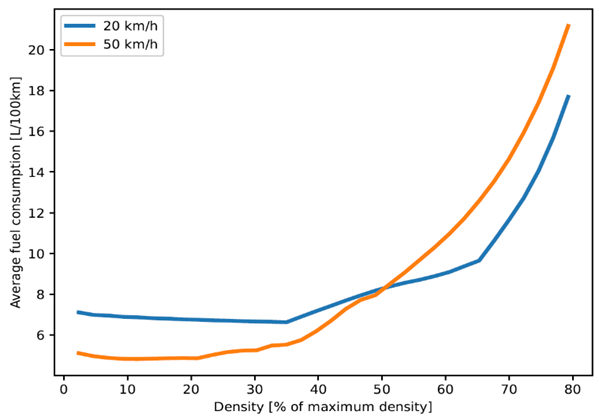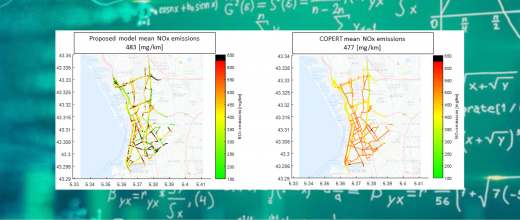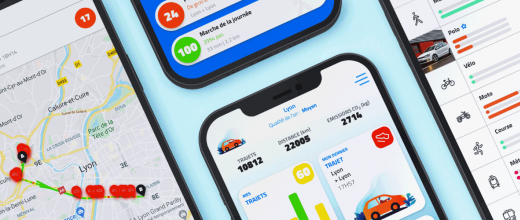23.02.2023
4 minutes of reading
Urban speed limits are one of the solutions available to big cities to improve traffic flow, to raise air quality, to rein in noise and to improve road safety. The prospect of additional benefits by adapting this limitation in real time, depending on traffic density, led an IFPEN team to evaluate this approach as part of a thesis work. The first part of this work assessed the effect of traffic congestion on fuel consumption. Subsequently, a regulation tool was designed to adjust the speed limits in a city in real time. Lastly, the merit of this approach was assessed and compared to those of other methods in a representative case study.
Getting around in big cities: multiple challenges for decision-makers
When it comes to modifying transport infrastructure or influencing mobility habits, big cities are up against various issues: road safety, air quality, traffic flow, noise pollution, etc.
Driven by environmental and energy frugality challenges, there is growing interest in vehicle fuel efficiency and emissions. Changes in behaviour or habits may be necessary, such as changes in speed limits to reduce traffic congestion and associated air pollution.
Assessing its impact compared to that of other measures is therefore paramount, to convey what the real-world benefits are and to bring improved user uptake within reach.
An IFPEN team worked on this subject as part of a thesis in collaboration with Gipsa-lab 1, and developed a dynamic tool for regulating speed limits zone by zone. The tool in question is based on a prediction of traffic conditions.
1 The GIPSA-lab laboratory (Grenoble Images Parole Signal Automatique) is a unit common to CNRS, Grenoble-INP and the University of Grenoble-Alpes, which conducts research on signals and systems.
Speed limits adjusted to rein in overconsumption of fuel depending on the traffic density
A first step in the study was to establish the effect of traffic congestion on fuel overconsumption under various speed limits, by coupling:
- a traffic simulator to reproduce vehicle dynamics at various levels of congestion;
- and a model developed by IFPEN to estimate the consumption and pollutant emissions of a vehicle extremely accurately depending on its powertrain technologies, the road conditions, driving style and network configuration, etc.
Figure 1 shows the average fuel consumption of vehicles at steady speeds with various levels of traffic density, under speed limits of 20 kmph and 50 kmph.
Where traffic density is low, it seems that a speed limit of 50 kmph is more energy efficient due to the more favourable engine speed, as long as traffic remains free-flowing. Conversely, above a certain density, a speed limit of 20 kmph becomes less energy-consuming. This is because the accordion effect kicks in later, and the associated accelerations, which are largely to blame for overconsumption, are more moderate.

Preempting road conditions to better regulate speed limits
Following these observations, a regulator was designed to adjust the speed limits of an urban area in real time [1] [2]. This tool, shown in Figure 2, comprises predictive models based on traffic demand, i.e. all the vehicles and their routes.

These models make it possible to estimate, on one hand, changes in traffic (model based on fluid mechanics) and on the other hand, changes in the associated fuel consumption (model based on Artificial Intelligence algorithms). The regulator was coupled with traffic simulator to assess its performance. This made it possible to create varying traffic dynamics and to arrive at a score for the consumption, emissions and average journey time of the vehicles included in the simulation.
Implementation of the regulator in a case study
A real-world case study of the impact of speed limit regulation is shown in Figure 3. It concerns a road network spanning about 28 km, comprising an urban area and a suburban area.

In this pedagogical example, some vehicles are in the network from the start and others appear during the simulation. The location of the latter is shown either by red dots if the vehicles come from the urban area (endogenous) or by black dots if they come from outside (exogenous). All vehicles travel through the road network until they reach their respective destinations (shown by the black circles). Clusters of road sections are plotted so as to identify parts of the network with similar characteristics. Roads in the same cluster are regulated by the same speed limit, so as to make it easier to solve the problem of optimisation.
The simulated scenario is one of rush hour, the aim being to create a congestion situation in the network and analyse the regulator’s behaviour. solve the problem of optimisation.
The effect it has is compared to that of two other scenarios:
• a reference scenario: a situation with constant speed limit zones;
• and a scenario known as "access control": a situation with regulated green light timeframes.
Figure 4 illustrates the results yielded.

Multiple benefits
The study shows that regulating speed limits makes it possible to:
• Improve traffic flow
• Reduce fuel consumption
• Reduce pollutant emissions
In practice, the regulator slightly lowers the speed limits of road sections leading to zones that are about to become congested. This preemptive action makes it possible to rein in congestion and the resulting overconsumption and excessive emissions. This also improves traffic flow since, over a given simulation time, the total distance covered by all vehicles is lengthened.
Thanks to the regulator developed, this thesis work demonstrated the energy efficiency and environmental benefit of speed limit regulation in urban areas, operated in preventative mode, to preempt congestion.
Furthermore, it turns out that this method is more advantageous than traffic light control, not least due to more moderate acceleration and less frequent stops. These result in better fuel efficiency and improved traffic flow [3].
To take it further, this eco-management tool for speed limit management could be implemented on more complex road networks and show its full potential in our cities. It could also be coupled with other methods of optimising the energy efficiency of vehicles such as eco-driving, eco-routing or cooperation between vehicles [4].
References
[1] B. Othman, G. De Nunzio, D. Di Domenico, C. Canudas-de-Wit, “Analysis of the impact of variable speed limits on environmental sustainability and traffic performance in urban networks”, IEEE Transactions on Intelligent Transportation Systems, 2022. (DOI : 10.1109/TITS.2022.3192129).
[2] B. Othman, “Limitations de vitesse variables et contrôle d'accès dans un réseau routier urbain pour une meilleure durabilité environnementale”, thèse de doctorat, 2021.
[3] B. Othman, G. De Nunzio, D. Di Domenico, C. Canudas-de-Wit, “Urban road traffic fuel consumption optimization via variable speed limits or signalized access control: A comparative study”, IEEE Conference on Decision and Control (CDC), 2021. (DOI : 10.1109/CDC45484.2021.9683194).
[4] B. Othman, G. De Nunzio, A. Sciarretta, D. Di Domenico, C. Canudas-de-Wit, “Connectivity and automation as enablers for energy-efficient driving and road traffic management”, Handbook of Climate Change Mitigation and Adaptation, 2021. (DOI : 10.1007/978-1-4614-6431-0_128-1).
Scientific contacts : Bassel Othman, Giovanni De Nunzio








